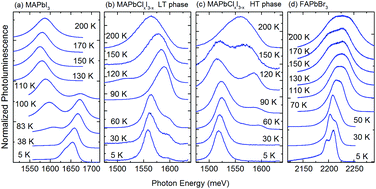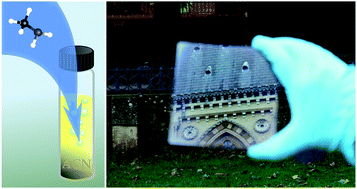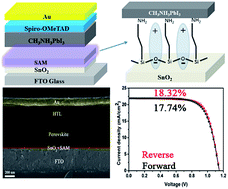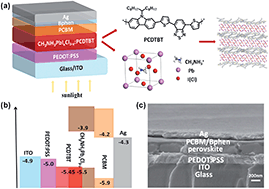16 Feb 06:14
J. Mater. Chem. A, 2017, 5,5486-5494
DOI: 10.1039/C7TA00589J, Paper
Wanchun Xiang, Qi Chen, Yiyuan Wang, Meijin Liu, Fuzhi Huang, Tongle Bu, Taishan Wang, Yi-Bing Cheng, Xiao Gong, Jie Zhong, Peng Liu, Xi Yao, Xiujian Zhao
A hydroscopic and flexible copolymer has been successfully employed in the fabrication of perovskite solar cells with high photovoltaic performance and enhanced stability.
The content of this RSS Feed (c) The Royal Society of Chemistry
15 Feb 04:47
by Yuhai Zhang, Makhsud I. Saidaminov, Ibrahim Dursun, Haoze Yang, Banavoth Murali, Erkki Alarousu, Emre Yengel, Buthainah A. Alshankiti, Osman M. Bakr and Omar F. Mohammed

The Journal of Physical Chemistry Letters
DOI: 10.1021/acs.jpclett.7b00105

14 Feb 12:02
Nanoscale, 2017, 9,3222-3230
DOI: 10.1039/C7NR00355B, Paper
K. Galkowski, A. A. Mitioglu, A. Surrente, Z. Yang, D. K. Maude, P. Kossacki, G. E. Eperon, J. T.-W. Wang, H. J. Snaith, P. Plochocka, R. J. Nicholas
Local photoluminescence measurements of organic-inorganic tri-halide perovskites show a temperature dependent crystal domain structure closely related to device performance.
The content of this RSS Feed (c) The Royal Society of Chemistry

14 Feb 02:21
by Min-Chuan Shih, Shao-Sian Li, Cheng-Hua Hsieh, Ying-Chiao Wang, Hung-Duen Yang, Ya-Ping Chiu, Chia-Seng Chang and Chun-Wei Chen

Nano Letters
DOI: 10.1021/acs.nanolett.6b04803

14 Feb 02:20
by Daniel Amgar, Avigail Stern, Dvir Rotem, Danny Porath and Lioz Etgar

Nano Letters
DOI: 10.1021/acs.nanolett.6b04381

14 Feb 02:20
by Connor G. Bischak, Craig L. Hetherington, Hao Wu, Shaul Aloni, D. Frank Ogletree, David T. Limmer and Naomi S. Ginsberg

Nano Letters
DOI: 10.1021/acs.nanolett.6b04453

14 Feb 02:19
by Samuel Berweger, Gordon A. MacDonald, Mengjin Yang, Kevin J. Coakley, Joseph J. Berry, Kai Zhu, Frank W. DelRio, Thomas M. Wallis and Pavel Kabos

Nano Letters
DOI: 10.1021/acs.nanolett.6b05119

14 Feb 02:19
by Smritakshi P. Sarmah, Victor M. Burlakov, Emre Yengel, Banavoth Murali, Erkki Alarousu, Ahmed M. El-Zohry, Chen Yang, Mohd S. Alias, Ayan A. Zhumekenov, Makhsud I. Saidaminov, Namchul Cho, Nimer Wehbe, Somak Mitra, Idris Ajia, Sukumar Dey, Ahmed E. Mansour, Maged Abdelsamie, Aram Amassian, Iman S. Roqan, Boon S. Ooi, Alain Goriely, Osman M. Bakr and Omar F. Mohammed

Nano Letters
DOI: 10.1021/acs.nanolett.7b00031

14 Feb 02:18
by Jae Keun Nam, Sung Uk Chai, Wonhee Cha, Yung Ji Choi, Wanjung Kim, Myung Sun Jung, Jeong Kwon, Dongho Kim and Jong Hyeok Park

Nano Letters
DOI: 10.1021/acs.nanolett.7b00050

08 Feb 01:14
by Yao Gao, Yunfeng Deng, Hongkun Tian, Jidong Zhang, Donghang Yan, Yanhou Geng, Fosong Wang

Using a “multifluorination” strategy, ambipolar donor–acceptor conjugated polymer with hole and electron mobility (μh and μe) up to 3.94 and 3.50 cm2 V−1 s−1, respectively, and unipolar n-type donor–acceptor conjugated polymers with μe up to 4.97 cm2 V−1 s−1 is synthesized with isoindigo as acceptor units.
08 Feb 01:13
by Hua Zhang, Huan Wang, Spencer T. Williams, Dehua Xiong, Wenjun Zhang, Chu-Chen Chueh, Wei Chen, Alex K.-Y. Jen
Despite the breakthrough of over 22% power conversion efficiency demonstrated in organic–inorganic hybrid perovskite solar cells (PVSCs), critical concerns pertaining to the instability and toxicity still remain that may potentially hinder their commercialization. In this study, a new chemical approach using environmentally friendly strontium chloride (SrCl2) as a precursor for perovskite preparation is demonstrated to result in enhanced device performance and stability of the derived hole-conductor-free printable mesoscopic PVSCs. The CH3NH3PbI3 perovskite is chemically modified by introducing SrCl2 in the precursor solution. The results from structural, elemental, and morphological analyses show that the incorporation of SrCl2 affords the formation of CH3NH3PbI3(SrCl2)x perovskites endowed with lower defect concentration and better pore filling in the derived mesoscopic PVSCs. The optimized compositional CH3NH3PbI3(SrCl2)0.1 perovskite can substantially enhance the photovoltaic performance of the derived hole-conductor-free device to 15.9%, outperforming the value (13.0%) of the pristine CH3NH3PbI3 device. More importantly, the stability of the device in ambient air under illumination is also improved.

A new compositional perovskite, CH3NH3PbI3(SrCl2)0.1 with more compact morphology and lower defect concentration is presented. Consequently, a power conversion efficiency of 15.9% with enhanced stability is achieved by employing the structure of hole-conductor-free fully printable mesoscopic perovskite solar cell.
08 Feb 01:12
by Tanghong Yi, Wei Chen, Lei Cheng, Ryan D. Bayliss, Feng Lin, Michael R. Plews, Dennis Nordlund, Marca M. Doeff, Kristin A. Persson and Jordi Cabana

Chemistry of Materials
DOI: 10.1021/acs.chemmater.6b04181

06 Feb 06:30
Energy Environ. Sci., 2017, 10,145-152
DOI: 10.1039/C6EE02373H, Paper
Nakita K. Noel, Severin N. Habisreutinger, Bernard Wenger, Matthew T. Klug, Maximilian T. Horantner, Michael B. Johnston, Robin J. Nicholas, David T. Moore, Henry J. Snaith
We present a new solvent system which has the potential to overcome the manufacturing barriers associated with the currently used toxic high boiling point solvents.
The content of this RSS Feed (c) The Royal Society of Chemistry

06 Feb 06:27
by Taisuke Matsui, Ji-Youn Seo, Michael Saliba, Shaik M. Zakeeruddin, Michael Grätzel

A room-temperature perovskite material yielding a power conversion efficiency of 18.1% (stabilized at 17.7%) is demonstrated by judicious selection of cations. Both cesium and methylammonium are necessary for room-temperature formamidinium-based perovskite to obtain the photoactive crystalline perovskite phase and high-quality crystals. This room-temperature-made perovskite material shows great potential for low-cost, large-scale manufacturing such as roll-to-roll processing.
06 Feb 06:26
by Chen Tao, Jeroen Van Der Velden, Lydia Cabau, Nuria F. Montcada, Stefanie Neutzner, Ajay Ram Srimath Kandada, Sergio Marras, Luigi Brambilla, Matteo Tommasini, Weidong Xu, Roberto Sorrentino, Andrea Perinot, Mario Caironi, Chiara Bertarelli, Emilio Palomares, Annamaria Petrozza

Fully solution-processed direct perovskite solar cells with a planar junction are realized by incorporating a cross-linked [6,6]-phenyl-C61-butyric styryl dendron ester layer as an electron extracting layer. Power conversion efficiencies close to 19% and an open-circuit voltage exceeding 1.1 V with negligible hysteresis are delivered. A perovskite film with superb optoelectronic qualities is grown, which reduces carrier recombination losses and hence increases V
oc.
06 Feb 06:26
by Xianxiong He, Peng Liu, Haihua Zhang, Qing Liao, Jiannian Yao, Hongbing Fu

A polydimethylsiloxane cylindrical-hole-template-confined solution-growth method is developed to fabricate densely packed CsPbCl3−
x
Br
x
microdisk laser arrays. Furthermore, a strategy to integrate multicolored microdisk laser (MDL) arrays is demonstrated that simultaneously lase in the deep blue, blue, cyan, and green by means of gas-phase replacement of Cl by Br from initial CsPbCl3 MDLs in HBr vapor.
06 Feb 06:25
by Hong Zhang, Jiaqi Cheng, Dan Li, Francis Lin, Jian Mao, Chunjun Liang, Alex K.-Y. Jen, Michael Grätzel, Wallace C. H. Choy

A new, all room-temperature solution process is developed to fabricate efficient, low-cost, and stable perovskite solar cells (PVSCs). The PVSCs show high efficiency of 17.10% and 14.19%, with no hysteresis on rigid and flexible substrates, respectively, which are the best efficiencies reported to date for PVSCs fabricated by room-temperature solution-processed techniques. The flexible PVSCs show a remarkable power-per-weight of 23.26 W g−1.
06 Feb 06:20
by Wenchao Huang, Eliot Gann, Naresh Chandrasekaran, Shyamal K. K. Prasad, Sheng-Yung Chang, Lars Thomsen, Dinesh Kabra, Justin M. Hodgkiss, Yi-Bing Cheng, Yang Yang, Christopher R. McNeill
The morphology, photophysics, and device performance of solar cells based on the low bandgap polymer poly[[2,6′-4,8-di(5-ethylhexylthienyl)benzo[1,2-b;3,3-b]dithiophene]3-fluoro-2[(2-ethylhexyl)carbonyl]thieno[3,4-b]thiophenediyl (PBDTTT-EFT) (also known as PTB7-Th) blended with different fullerene acceptors: Phenyl-C61-butyric acid methyl ester (PC61BM), phenyl-C71 -butyric acid methyl ester (PC71BM), or indene-C60 bisadduct (ICBA) are correlated. Compared to PC71 BM-based cells – which achieve a power conversion efficiency (PCE) of 9.4% – cells using ICBA achieve a higher open-circuit voltage (VOC) of 1.0 V albeit with a lower PCE of 7.1%. To understand the origin of this lower PCE, the morphology and photophysics have been thoroughly characterized. Hard and soft X-ray scattering measurements reveal that the PBDTTT-EFT:ICBA blend has a lower crystallinity, lower domain purity, and smaller domain size compared to the PBDTTT-EFT:PC71BM blend. Incomplete photoluminescence quenching is also found in the ICBA blend with transient absorption measurements showing faster recombination dynamics at short timescales. Transient photovoltage measurements highlight further differences in recombination at longer timeframes due to the more intermixed morphology of the ICBA blend. Interestingly, a mild thermal treatment improves the performance of PBDTTT-EFT:ICBA cells which is exploited in the fabrication of a homo PBDTTT-EFT:ICBA tandem solar cell with PCE of 9.0% and VOC of 1.93 V.

The mixing behavior of a high-efficiency polymer with various fullerene derivatives is investigated. Compared to solar cells using either PC61BM or PC71 BM as acceptor, cells using ICBA have a lower efficiency due to a more intermixed morphology. ICBA blends, however, show a higher thermal stability which is exploited in the fabrication of homo-tandem cells with 9.0% power conversion efficiency.
06 Feb 06:19
by Hsinhan Tsai, Wanyi Nie, Yen-Hao Lin, Jean Christophe Blancon, Sergei Tretiak, Jacky Even, Gautam Gupta, Pulickel M. Ajayan, Aditya D. Mohite
Perovskite materials due to their exceptional photophysical properties are beginning to dominate the field of thin-film optoelectronic devices. However, one of the primary challenges is the processing-dependent variability in the properties, thus making it imperative to understand the origin of such variations. Here, it is discovered that the precursor solution aging time before it is cast into a thin film, is a subtle but a very important factor that dramatically affects the overall thin-film formation and crystallinity and therein factors such as grain growth, phase purity, surface uniformity, trap state density, and overall solar cell performance. It is shown that progressive aging of the precursor promotes efficient formation of larger seeds after the fast nucleation of a large density of small seeds. The hot-casting method then leads to the growth of large grains in uniform thin-films with excellent crystallinity validated using scanning microscopy images and X-ray diffraction patterns. The high-quality films cast from aged solution is ideal for thin-film photovoltaic device fabrication with reduced shunt current and good charge transport. This observation is a significant step toward achieving highly crystalline thin-films with reliability in device performance and establishes the subtle but dramatic effect of solution aging before fabricating perovskite thin-films.

A direct correlation between precursor aging time and crystalline quality of hybrid perovskite-based thin films is discovered and systematically elucidated. Progressive aging of precursor results in a pinhole-free thin film with optimal phase purity that results in high-efficiency planar solar cells.
06 Feb 06:19
by Mingzhu Long, Tiankai Zhang, Wangying Xu, Xiaoliang Zeng, Fangyan Xie, Qiang Li, Zefeng Chen, Fengrui Zhou, Kam Sing Wong, Keyou Yan, Jianbin Xu

Deliberate halide exchange between unstable intermediate HPbI2Br and nonstoichiometric FAI is employed to produce high-quality FAPbI3–xBrx (x ≈ 0.44), which eliminates the use of antisolvent dripping and other post-treatment techniques. The obtained perovskite thin film demonstrates high crystallinity and a large and compact crystal domain up to 2–3 µm. The corresponding device shows power conversion efficiency of up to around 19.0%, with reliable stability and reproducibility.
06 Feb 06:18
by Seth M. McAfee, Sergey V. Dayneko, Pierre Josse, Philippe Blanchard, Clément Cabanetos and Gregory C. Welch

Chemistry of Materials
DOI: 10.1021/acs.chemmater.6b04862

06 Feb 04:45
by Claudio Quarti, Filippo De Angelis and David Beljonne

Chemistry of Materials
DOI: 10.1021/acs.chemmater.6b03259

06 Feb 04:44
by Thumu Udayabhaskararao, Miri Kazes, Lothar Houben, Hong Lin and Dan Oron

Chemistry of Materials
DOI: 10.1021/acs.chemmater.6b04841

06 Feb 04:44
by Alexander Sharenko, Cameron Mackeen, Leila Jewell, Frank Bridges and Michael F. Toney

Chemistry of Materials
DOI: 10.1021/acs.chemmater.6b04917

13 Jan 12:41
by Qinglong Jiang, Mingming Chen, Junqiang Li, Mingchao Wang, Xiaoqiao Zeng, Tiglet Besara, Jun Lu, Yan Xin, Xin Shan, Bicai Pan, Changchun Wang, Shangchao Lin, Theo Siegrist, Qiangfeng Xiao and Zhibin Yu

ACS Nano
DOI: 10.1021/acsnano.6b08004

13 Jan 11:58
by Qing-Dong Ou, Chi Li, Qian-Kun Wang, Yan-Qing Li, Jian-Xin Tang
Metal halide perovskites, a class of crystalline semiconductors with unique optical and electronic properties, are emerging as potential solutions for low-cost photovoltaics and photonic sources in fields of solar cells, sensors, light-emitting diodes and lasers. Regardless of significant progress on device efficiency with the control over perovskite structures and film morphologies, unveiling the interface energetics and band alignment of these perovskite systems is indispensable for the performance optimization in the optoelectronic applications by grasping the photon harvest and charge transport processes. Herein we review the recent advances in the energetics of metal halide perovskite interfaces. The electronic properties of perovskite materials are addressed in terms of halide substitution, thermal annealing and substrate effects as well as trap states. The energy level alignments of interfaces between perovskite films and charge transport layers are then discussed, which is correlated to the photovoltaic properties in perovskite solar cells.

Recent advances in energetics in metal halide perovskite interfaces are reviewed with a combined discussion of electronic structures of metal halide perovskites and energy level alignment at perovskite/organic heterointerfaces through photoemission spectroscopy techniques. The energetics at the perovskite interfaces with various carrier transport materials is highlighted, suggesting the impact on photocurrent generation process in perovskite solar cells.
06 Jan 00:37
by Chenxin Ran, Zhaoxin Wu, Jun Xi, Fang Yuan, Hua Dong, Ting Lei, Xin He and Xun Hou

The Journal of Physical Chemistry Letters
DOI: 10.1021/acs.jpclett.6b02578

06 Jan 00:35
J. Mater. Chem. A, 2017, 5,1658-1666
DOI: 10.1039/C6TA08783C, Paper
Guang Yang, Changlei Wang, Hongwei Lei, Xiaolu Zheng, Pingli Qin, Liangbin Xiong, Xingzhong Zhao, Yanfa Yan, Guojia Fang
APTES-SAM as an efficient interfacial layer in planar perovskite solar cells, optimizing the interface and enhancing performance.
The content of this RSS Feed (c) The Royal Society of Chemistry
05 Jan 11:32
by Behrad Gholipour, Giorgio Adamo, Daniele Cortecchia, Harish N. S. Krishnamoorthy, Muhammad. D. Birowosuto, Nikolay I. Zheludev, Cesare Soci

Organometallic perovskites, solution-processable materials with outstanding optoelectronic properties and high index of refraction, provide a platform for all-dielectric metamaterials operating at visible frequencies. Perovskite metasurfaces with structural coloring tunable across visible frequencies are realized through subwavelength structuring. Moreover, a threefold increase of the luminescence yield and comparable reduction of luminescence decay time are observed.
05 Jan 00:37
J. Mater. Chem. A, 2017, 5,2572-2579
DOI: 10.1039/C6TA08970D, Paper
Cong-Cong Zhang, Meng Li, Zhao-Kui Wang, Yu-Rong Jiang, Hai-Rui Liu, Ying-Guo Yang, Xing-Yu Gao, Heng Ma
Photovoltaic performance of planar perovskite solar cells has been improved by mixing CH3NH3PbIxCl3-x and a donor polymer [N-9[prime or minute][prime or minute]-hepta-decanyl-2,7-carbazole-alt-5,5-(4[prime or minute],7[prime or minute]-di-2-thienyl-2[prime or minute],1[prime or minute],3[prime or minute]-benzothiadiaz-ole)].
The content of this RSS Feed (c) The Royal Society of Chemistry





























